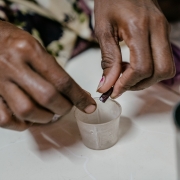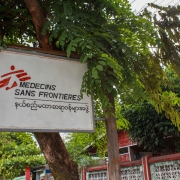
사진: 인도 뭄바이에 거주하고 있는 하니프(25세)가 결핵 약을 먹고 있다. 하니프는 결핵 내성의 가장 복잡한 형태인 '광범위내성(XDR-TB)' 환자로, 지난 3회 치료 모두 실패한 끝에 국경없는의사회 병원으로 이송돼 현재 신약 치료를 받고 있다. © Atul Loke/Panos Pictures
결핵(TB)
세계 인구의 3분의 1은 현재 결핵균에 감염되어 있지만, 이는 잠복 결핵 상태이기 때문에 증상도 보이지 않고 전염도 일어나지 않습니다. 하지만 일부 사람들의 경우, 면역력이 약해 잠복 결핵 감염이 급성 결핵으로 발전합니다. 해마다 1000만여 명이 활동성 결핵에 걸리고, 180만 명이 이로 인해 목숨을 잃습니다.
결핵은 감염자들이 기침이나 재채기를 할 때 공기를 통해 퍼집니다. 결핵에 감염된 사람 모두가 병에 걸리는 것은 아니며, 그중 10%가 사는 동안 활동성 결핵에 걸리게 됩니다. 결핵이 가장 영향을 많이 끼치는 장기는 폐입니다. 결핵의 주요 증상으로 끊임없는 기침, 고열, 체중 감소, 가슴 통증이 나타나며 호흡 곤란으로 사망에 이르는 경우도 있습니다. HIV 감염자 가운데 TB 감염 사례가 비교적 높게 나타나 이것이 주요한 사망 원인으로 작용합니다.
폐결핵 진단은 객담 검사로 이루어지는데, 아동에게는 이 검사가 어려울 수도 있습니다. 현재 분자 검사가 사용되고 있는데요. 단 두 시간 만에 검사 결과가 나오며, 약제내성 수준도 어느 정도 알아낼 수 있습니다. 하지만 분자 검사는 가격이 비싼 데다 객담 샘플도 필요하고 전력 공급도 충분해야 합니다.
비합병증 결핵 치료는 최소 6개월이 걸립니다. 가장 강력한 1차 항생제 2종(이소니아지드·리팜피신)에 내성을 보일 경우 다제내성 결핵(MDR-TB) 감염으로 간주합니다. MDR-TB는 치료가 불가능한 것은 아니지만, 2년간 힘겨운 약물 치료가 이어지고 부작용도 많습니다. 광범위 약제내성 결핵(XDR-TB)은 MDR-TB 치료에 사용하는 2차 결핵 치료제에도 내성을 보이는 경우를 말합니다. XDR-TB 치료는 매우 제한적입니다. 베다퀼린·델라마니드 등 신약 2종은 약제내성 결핵 환자들에게 더 나은 치료 결과를 안겨 줄 수 있지만, 현재 이 약들을 구하기가 매우 제한적인 실정입니다.
2016년, 국경없는의사회는 2만900명의 환자들을 대상으로 결핵 치료를 시작했는데, 그중 2700명이MDR-TB 환자였습니다.
Tuberculosis (TB)
One-third of the world’s population is currently infected with the tuberculosis (TB) bacillus but they have a latent form of the disease and so have no symptoms and cannot transmit it. In some people, the latent TB infection progresses to acute TB, often due to a weak immune system. Every year, over
10 million people develop active TB and 1.8 million die from it.
TB is spread through the air when infected people cough or sneeze. Not everyone infected with TB becomes ill, but 10 per cent will develop active TB at some point in their lives. The disease most often affects the lungs. Symptoms include a persistent cough, fever, weight loss, chest pain and breathlessness in the lead-up to death. Among people living with HIV, TB incidence is much higher, and is a leading cause of death.
Diagnosis of pulmonary TB depends on a sputum sample, which can be difficult to obtain from children. A molecular test that can give results after just two hours and can detect a certain level of drug resistance is now being used, but it is costly and still requires a sputum sample, as well as a reliable power supply.
A course of treatment for uncomplicated TB takes a minimum of six months. When patients are resistant to the two most powerful first-line antibiotics (isoniazid and rifampicin), they are considered to have multidrug-resistant TB (MDR-TB). MDR-TB is not impossible to treat, but the drug regimen is arduous, taking up to two years and causing many side effects. Extensively drug-resistant tuberculosis (XDR-TB) is identified when patients show resistance to second-line drugs administered for MDR-TB. The treatment options for XDR-TB are very limited. Two new drugs – bedaquiline and delamanid – can improve treatment outcomes for patients with drug-resistant versions of the disease, but their availability is currently limited.
MSF initiated 20,900 patients on treatment for TB in 2016, of which 2,700 for MDR-TB.














